Houseplants add a lot to indoor living spaces. Besides cleaning the air and adding humidity, houseplants also improve our mood and even our productivity. Most people choose houseplants that are easy to care for. Some are popular because of their color or ability to bloom all year long. Whatever the motivation, here are 25 of the most popular houseplants.
25. Bromeliads (Bromeliaceae)

The multicolored foliage of bromeliads adds color to any interior.
©Oliver Hoffman/Shutterstock.com
The colorful blooms of bromeliads make this plant very popular. Although some houseplants can be toxic to pets or young children, bromeliads are non-toxic. Somewhat slow-growing, they need one to three years to mature into a flowering plant. Striking for their beautiful foliage, their leaves are multicolored red, green, purple, yellow, and orange and will add a splash of color to any room.
24. Pilea (Pilea peperomioides)

Pilea is also called the Chinese money plant because of the shape of its leaves.
©Struzhkova Ilona/ via Getty Images
Because of its large, coin-shaped leaves, pilea is sometimes called the Chinese money plant or pancake plant. This is a fast-growing plant that requires low maintenance and can thrive in low-light areas. Because it is so easy to care for, it makes a great plant for beginners. In China, pileas are thought to bring good fortune and are popular as housewarming gifts.
23. ZZ Plant (Zamioculcas zamiifolia)
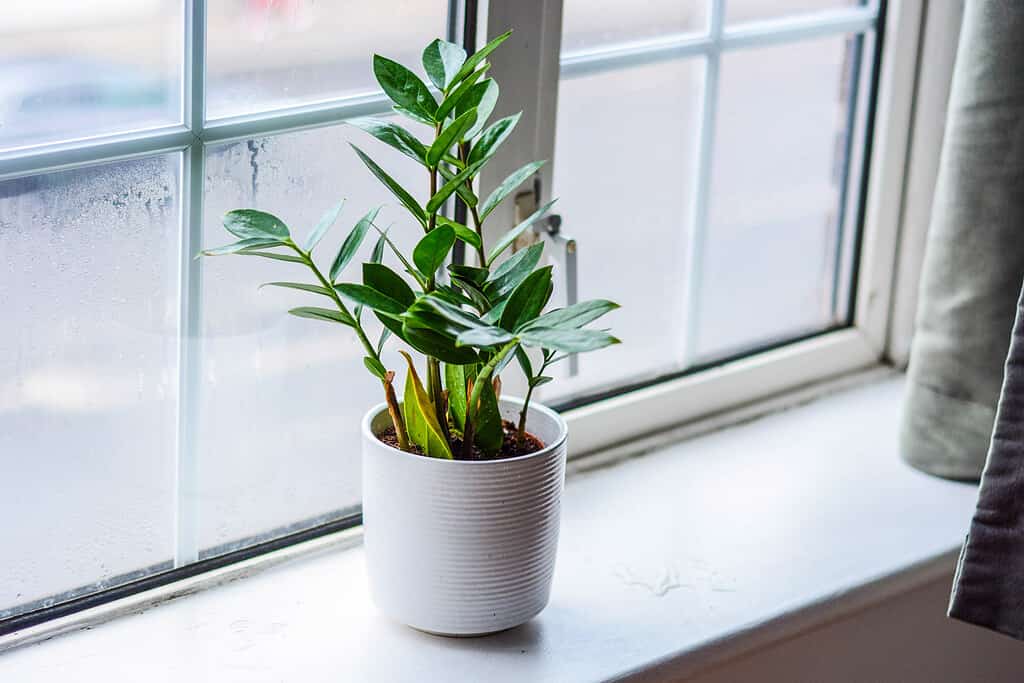
One plant that requires little maintenance is the ZZ plant.
©OleseaV/ via Getty Images
If you don’t have a green thumb, the ZZ plant is a good choice because it is hard to kill and will easily reach 24”–36” in height. ZZ plants require little attention and can even thrive on neglect. With waxy, oval, dark green leaves, they spruce up an office or spaces in your home that do not get much light. If you want to succeed with houseplants, the Zamioculcas Zamiifolia is a popular choice.
22. Monstera Deliciosa (Monstera)

Monstera make great hanging plants.
©Isabella Wand/Shutterstock.com
If you have a bright, open space in your home, the Monstera will make a statement. Striking in its appearance, the holes make the leaves resemble Swiss cheese. This tropical plant grows quickly (about 12” – 24” a year) and will be full-grown in three years. This plant is toxic to humans and pets, but in the right space, it will add beauty and elegance to your home and remains one of the most popular houseplants.
21. Dumb Cane Plant (Dieffenbachia)
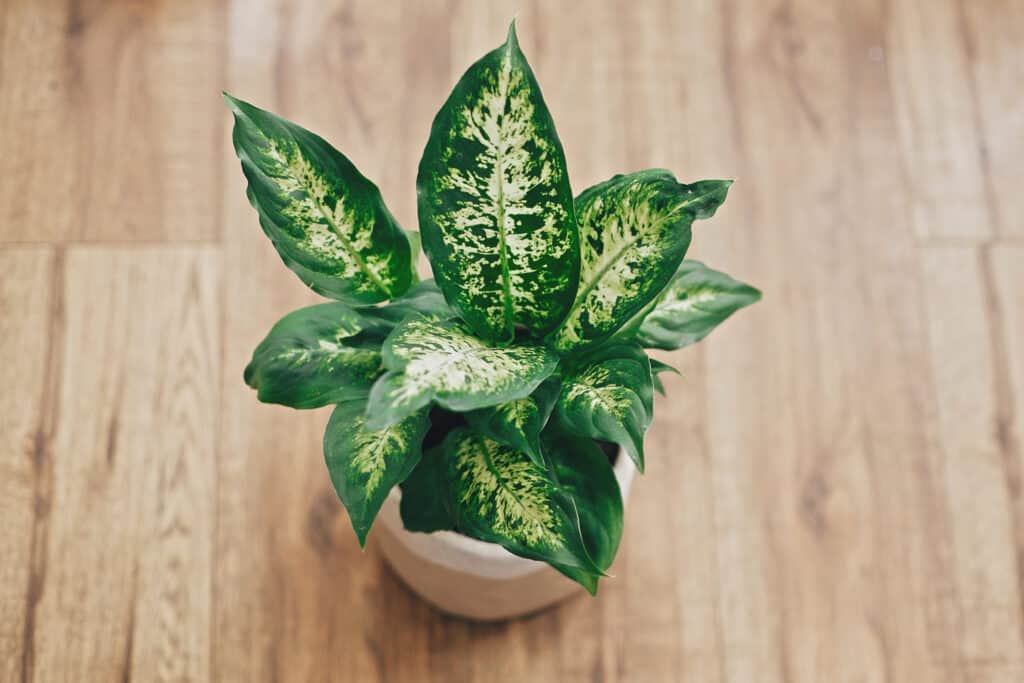
Dumb cane has unusual patterned foliage.
©iStock.com/Bogdan Kurylo
An easy-growing plant, the dumb cane typically grows to be 3 to 5 feet tall. Their patterned leaves of green, white, and cream create intriguing foliage. As a tropical plant, dumb cane thrives in high humidity but also does well in shady conditions. It is highly toxic to humans, dogs, and cats, but due to their easy-care nature, these houseplants continue to be popular.
20. Moth Orchid (Phalaenopsis amabilis)

The moth orchid is an elegant addition to your home decor.
©PAUL ATKINSON/Shutterstock.com
As a great year-round plant, the Moth Orchid produces elegant flowers. They have an exotic appearance but need very little to thrive. Flowers come in red, pink, yellow, peach, white, and purple. New gardeners love this plant because it does not require a lot of extra attention. This is one of the easiest orchids to grow. During those cold winters when we spend a lot of time indoors, the Moth Orchid will brighten up your home.
19. Cactus (Cactaceae)

A popular houseplant is the cactus because it thrives easily.
©Monontour/Shutterstock.com
Cacti are growing in popularity because they require very little care. As long as it gets bright light, a cactus will thrive even with little watering. As a succulent, these plants store water in their stems and will have either no leaves or very small leaves. Cacti come in a range of sizes and shapes and are easily identified by their prickly spines. Largely ornamental, this plant will add greenery and color to your home with very little maintenance.
18. Heartleaf Philodendron (Philodendron hederaceum)

The fast-growing philodendron does well in the average household temperature.
©Cheng Wei/Shutterstock.com
The philodendron is a tropical plant, native to Japan. People love these as houseplants because they are fast-growing, lush, and easy to care for. Watering this plant twice a week will result in healthy growth. Because of its heart-shaped leaves, philodendrons have earned the nickname “sweetheart plant.” First-time plant owners can be successful in growing these because they tolerate neglect, such as inconsistent watering, low light, and poor soil. Philodendrons make a good choice for people with busy lives or those who travel for extended periods.
17. Fiddle Leaf Fig (Ficus lyrata)

As a houseplant, the Fiddle Leaf can grow to 10 feet tall.
©Rachata Teyparsit/Shutterstock.com
Although the Fiddle Leaf plant is notoriously finicky, it remains one of the most popular houseplants. Because they are native to the rainforests in central and west Africa, fiddlers require warm and humid conditions. Yes, the Fiddle Leaf requires extra care, but this trendy, dramatic plant transforms any space in the house.
16. Areca Palm (Dypsis lutescens)

Loved for its lush and bushy appearance, the areca palm works well in bright spaces.
©Makabas/Shutterstock.com
If you want to make a bold statement in your room, the areca palm makes a great choice. This palm can grow up to eight feet tall, thrives in indirect sunlight, and is relatively easy to care for. Full and bushy in appearance, the areca palm will grow from 6” to 10” inches a year. This lush, ornamental, tropical palm requires plenty of light and humidity. Areca palms command attention in any room and are widely used in bright interiors.
15. Croton (Codiaeum variegatum)
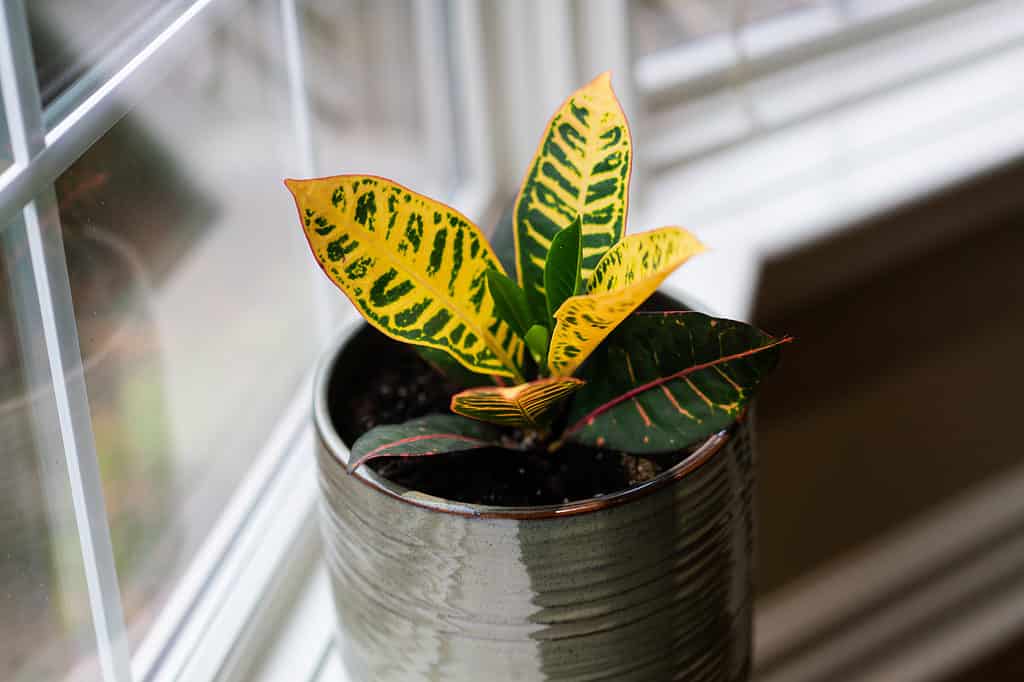
Their colorful leaves make crotons a popular choice for houseplants.
©iStock.com/Wirestock
Croton plants grow best outdoors and can be a challenge to grow indoors. Still, their colorful foliage makes them a best-seller on many plant sites. This plant remains small when grown in pots, which makes it ideal as a houseplant. Maintaining the ideal temperature and humidity presents the biggest challenges to indoor growing. Crotons also require a lot of light, and bright, indirect light is best. This plant may require more maintenance, but its show-stopping colors will brighten any room.
14. English Ivy (Hedera helix)

English Ivy is an evergreen that helps purify the air.
©ArtBackground/Shutterstock.com
If you have a dark corner in your room to brighten up, English Ivy makes a great choice, especially as a hanging plant. This fast-growing plant remains popular because it is easy to grow, looks elegant, and provides a variety of shades of green. This plant helps purify the air from mold spores and chemicals found in cleaning products. However, English ivy is also toxic to humans and pets and should remain out of reach. As a low-maintenance plant, English ivy brightens bedrooms and offices while adding a touch of elegance.
13. Rubber Plant (Ficus elastica)
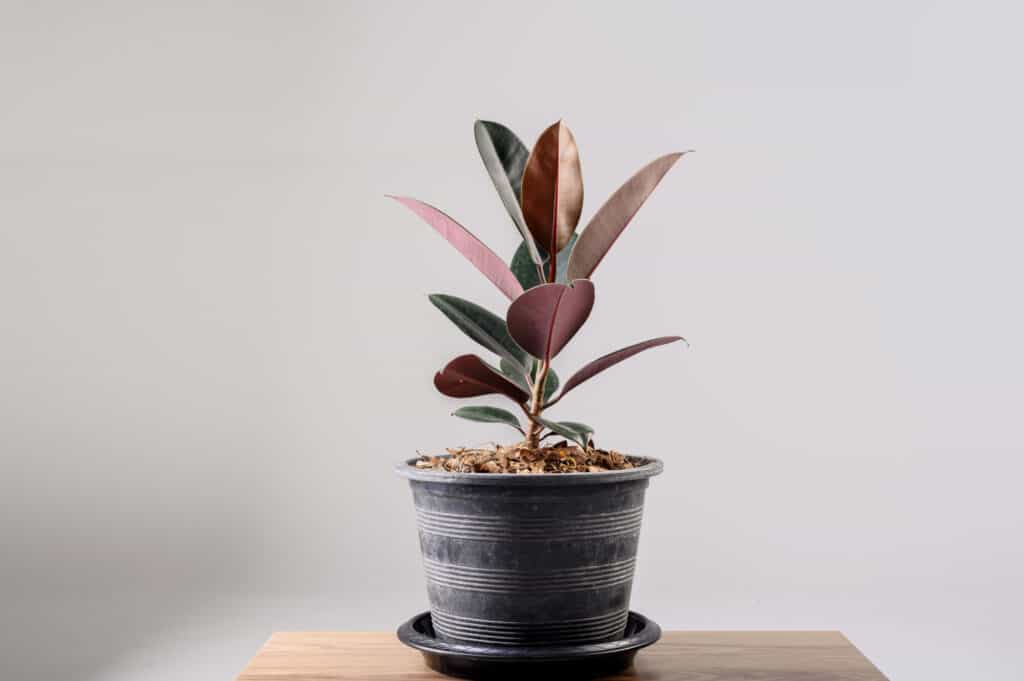
Rubber trees produce glossy, emerald leaves.
©ParkerDP/Shutterstock.com
As a native plant to Southeast Asia, the rubber plant produces oversized leaves with a vibrant emerald hue. This plant requires straightforward maintenance: adequate southern or eastern light, moisture, and warmth. Indoors, rubber plants can grow to a height of 10 feet tall. As this plant grows, it will require a long wooden dowel to keep it from drooping. With its striking leaves and height, this plant commands the attention of the room. Although rubber plants require more maintenance, they remain well-loved due to their rich color and shiny leaves.
12. Boston Fern (Nephrolepis exaltata)
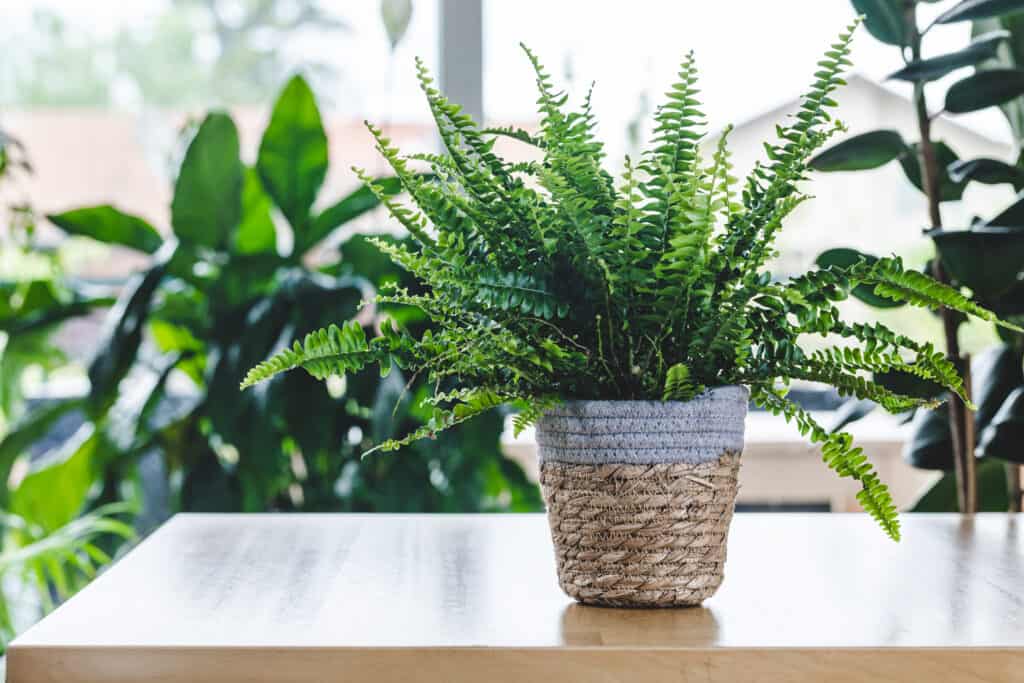
Boston ferns make cozy home decor.
©iStock.com/Benoitbruchez
Although the name implies otherwise, the Boston fern is not native to the northeastern United States. Instead, these plants can be found in tropical regions, swamps, and humid forests. Loved in the Victorian period, these ferns are still popular today. Because Boston ferns thrive in humidity, they make an ideal plant for the bathroom. And because they do not require much sunlight, they can also do well in darker rooms. Loved for its arching leaves, the plant looks especially good on a stand, where the leaves can cascade down. And as a bonus, NASA ranks Boston ferns as one of the top ten purifying plants.
11. Rosemary (Salvia rosmarinus)
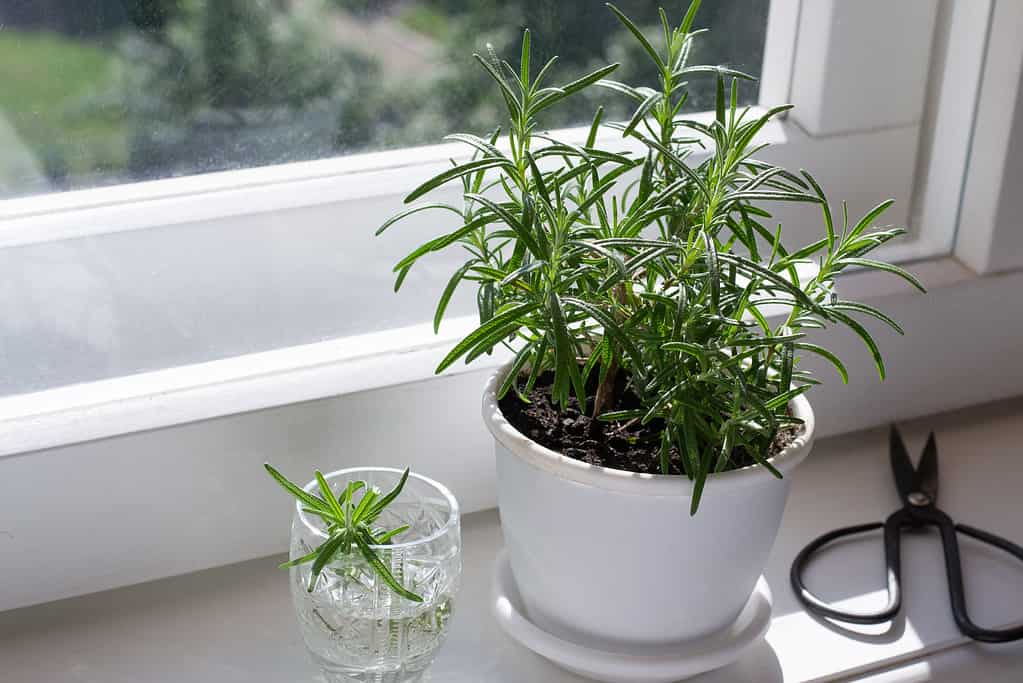
Rosemary will add color and flavor to your home.
©Albina Yalunina/iStock via Getty Images
A fragrant herb, rosemary can be grown inside as long as it gets bright sunlight. Like basil, oregano, and thyme, rosemary is a member of the mint family. Though it is known for its medicinal properties, most people enjoy this herb as a way to add taste to cooking. Because rosemary is a perennial plant, it will live more than two years. This herb will add color to your home, flavor to your cooking, and provide health benefits, such as antioxidants in your diet.
10. Basil (Ocimum basilicum)
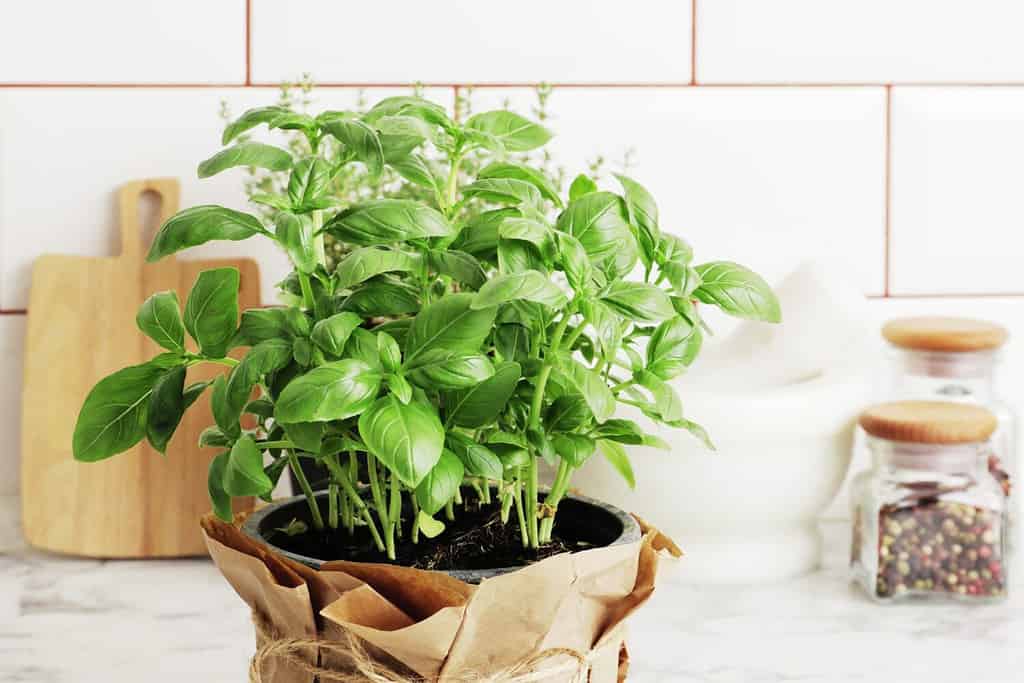
A culinary favorite, basil is used in cooking worldwide.
©PandaStudio/Shutterstock.com
Basil is also a popular herb to grow indoors. And if you love pesto, plan on growing several plants. Also a member of the mint family, this herb is versatile and aromatic. Basil adds flavor to meals, gives a nice fragrance to the room, and will grow well in a sunny window.
9. Jade Plant (Crassula)
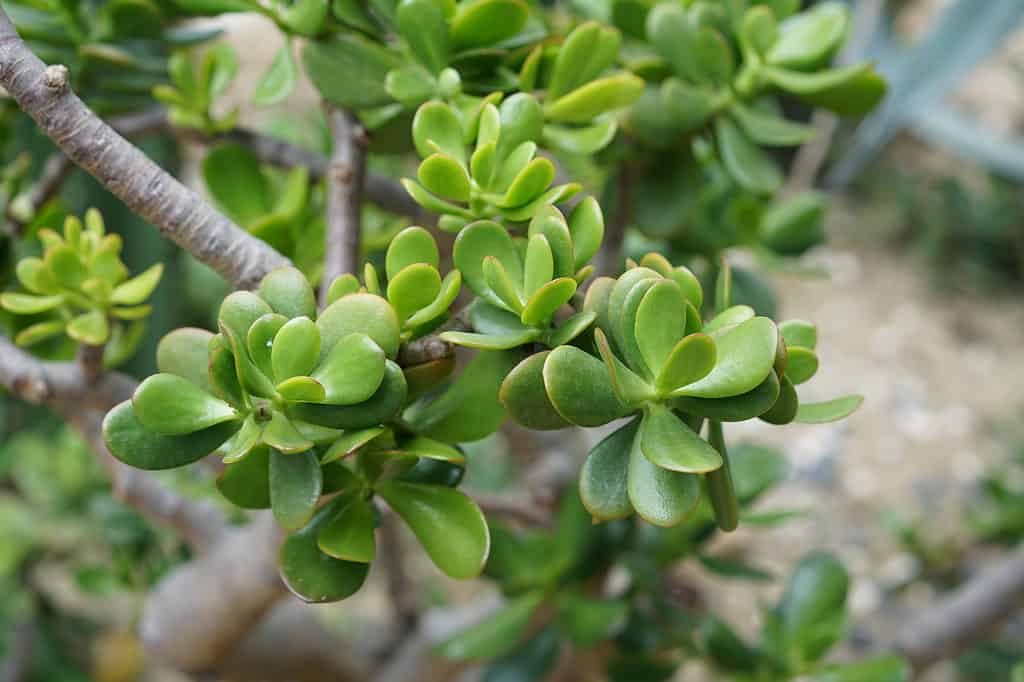
The classic look of jade plants makes them a popular choice.
©iStock.com/Wirestock
Succulents such as the jade plant have been popular for decades. If you are someone who neglects houseplants, this plant requires minimal watering. Jade plants can live a long time without proper care. With oval-shaped leaves, this plant has a tree-like appearance because of its thick, woody stems. Because of their classic look, jade plants make very appealing decorative houseplants.
8. African Violet (Saintpaulia Ionantha)
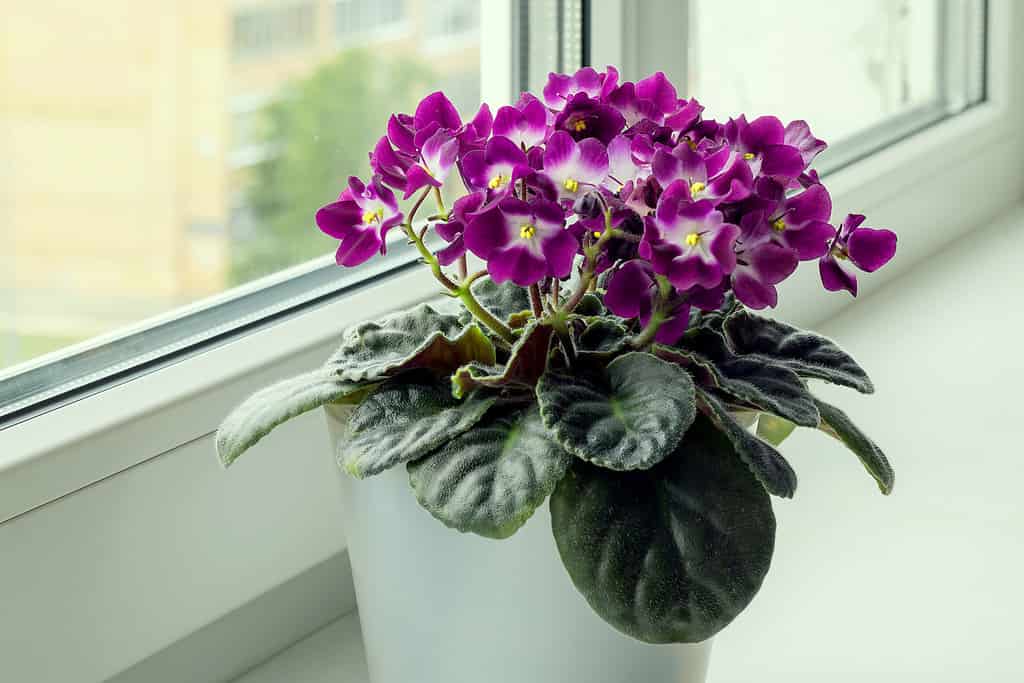
African violets produce vibrant purple flowers.
©Ludmila Kapustkina/iStock via Getty Images
Native to East Africa, the African violet grows in the tropical rainforests of Tanzania and Kenya. This plant is generally easy to care for. It will produce violet-colored blooms and flowers almost continuously. African violets do well in bright, indirect light and prefer warm conditions. A beautiful houseplant, it provides vibrant color for the indoors.
7. Spider Plant (Chlorophytum comosum)
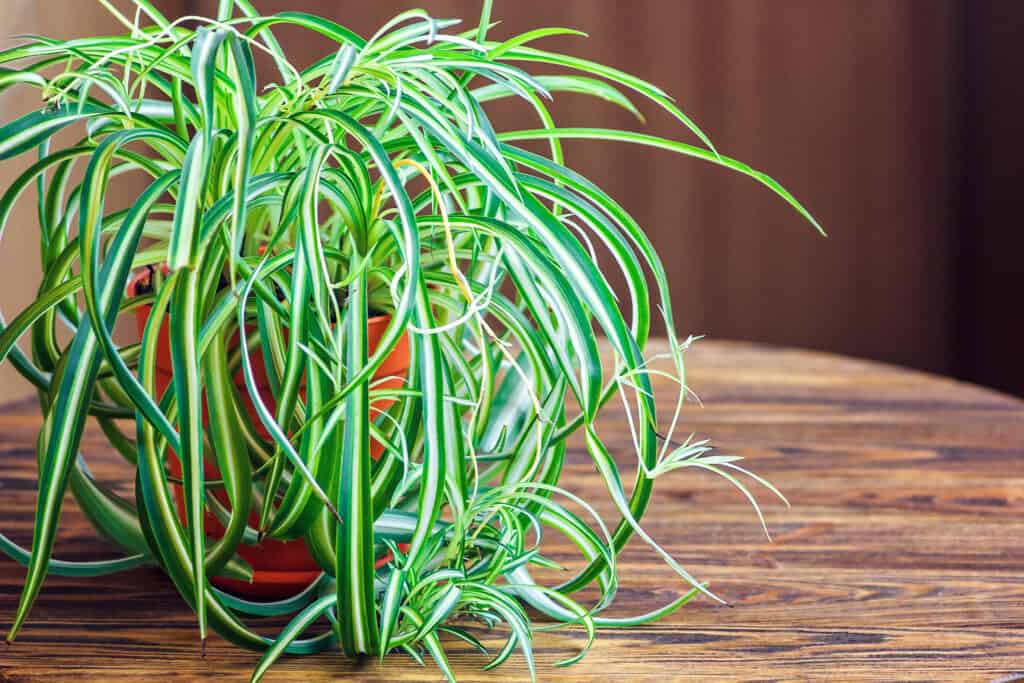
Spider plants thrive in moist environments.
©Bozhena Melnyk/Shutterstock.com
Despite the name, spider plants are very popular. Because their slender leaves will gently stretch from 12” to 18” long, they make great hanging plants. Spider plants are sometimes called spider ivy and grow moderately fast. They flower regularly with small, star-shaped flowers. With leaves that are striped green and white, spider plants make an attractive addition to any room.
6. Lucky Bamboo (Dracaena sanderiana)
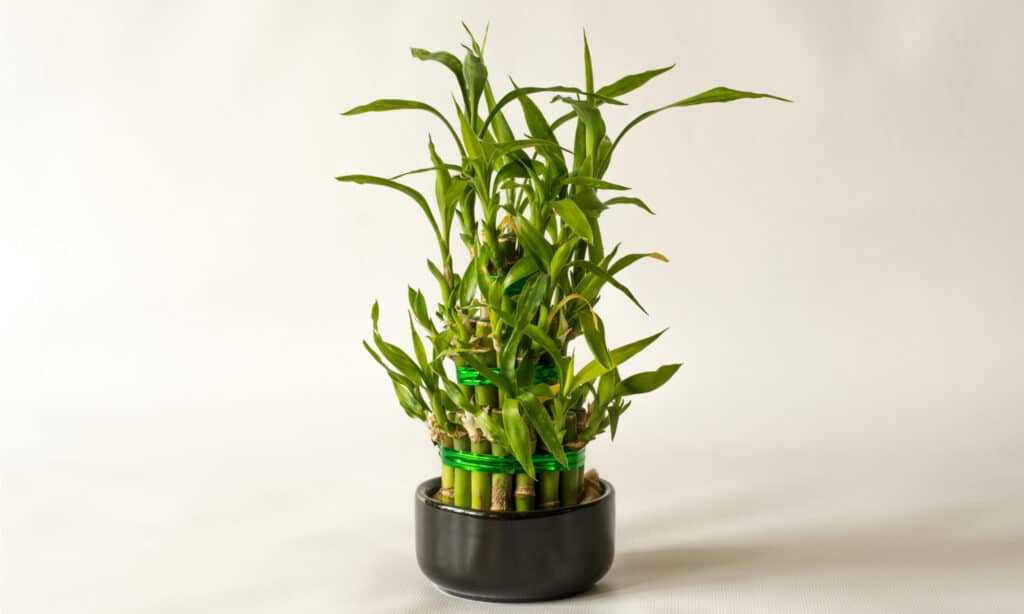
Lucky bamboo is hearty and ideal for novice gardeners.
©Nik Waller Productions/Shutterstock.com
This houseplant is not bamboo, but rather, a succulent. It is especially easy to care for: as long as the roots are in water, they will grow. With a combination of braided stalks, swirls, and small, floppy leaves, lucky bamboo makes an eye-catching addition to an office or home. According to Chinese traditions, lucky bamboo is believed to bring luck to your home.
5. Money Tree (Guiana chestnut)
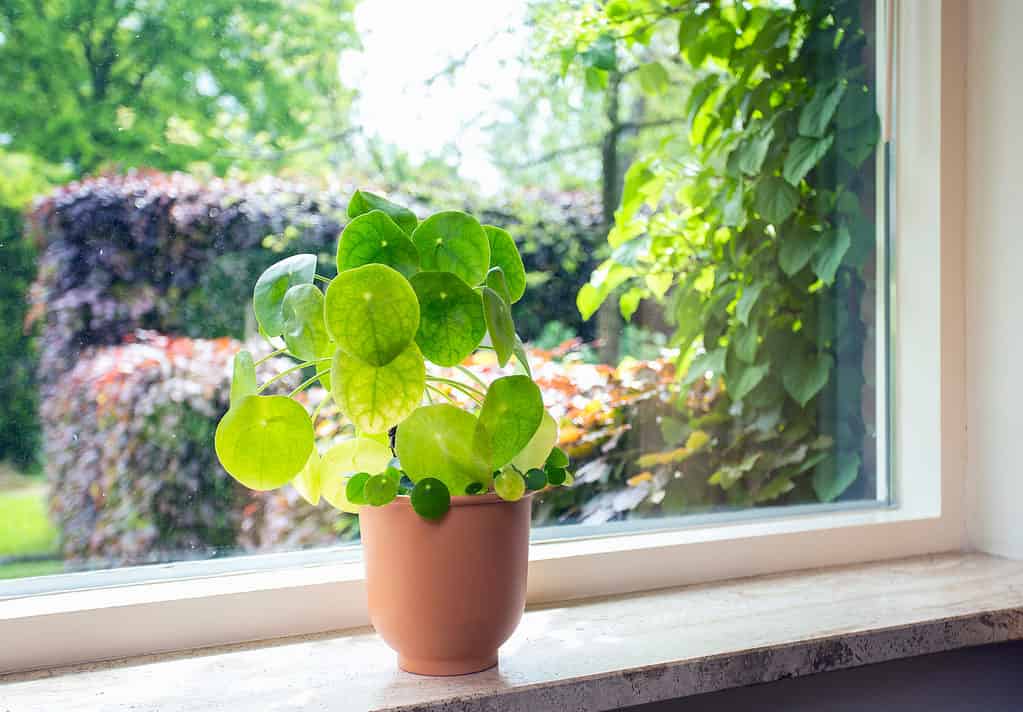
Many believe the money tree brings good luck to the home.
©A-photographyy/Shutterstock.com
Because of its ability to thrive indoors, the money tree has become very popular. Like lucky bamboo, the plant is also believed to bring good fortune to your home. Money trees grow quickly and make a stunning floor plant. Its star-shaped leaves and braided trunk give your home a tropical feel. Some believe the money tree reduces stress and anxiety.
4. Peace Lily (Spathiphyllum)

Peace lilies produce beautiful white flowers.
©iStock.com/Galina Tolochko
Symbolizing peace and prosperity, the peace lily is a favorite. It will bloom more than once a year, and its white flowers last for weeks. As a tropical evergreen plant, it requires consistent moisture and humidity. Most varieties will grow to a height of 16”. Because peace lilies are not cold-hardy, they do especially well indoors.
3. Snake Plant (Dracaena trifasciata)

The snake plant is a very resilient succulent.
©Adam Yee/Shutterstock.com
If you are a beginner with houseplants, the snake plant makes a great choice. Also called the devil’s tongue, its sword-shaped leaves grow upright. Snake plants can grow as high as several feet and have proven to be a resilient succulent. Benefits include filtering indoor air, boosting mental health, and being easy to care for.
2. Golden Pothos (Epipremnum aureum)
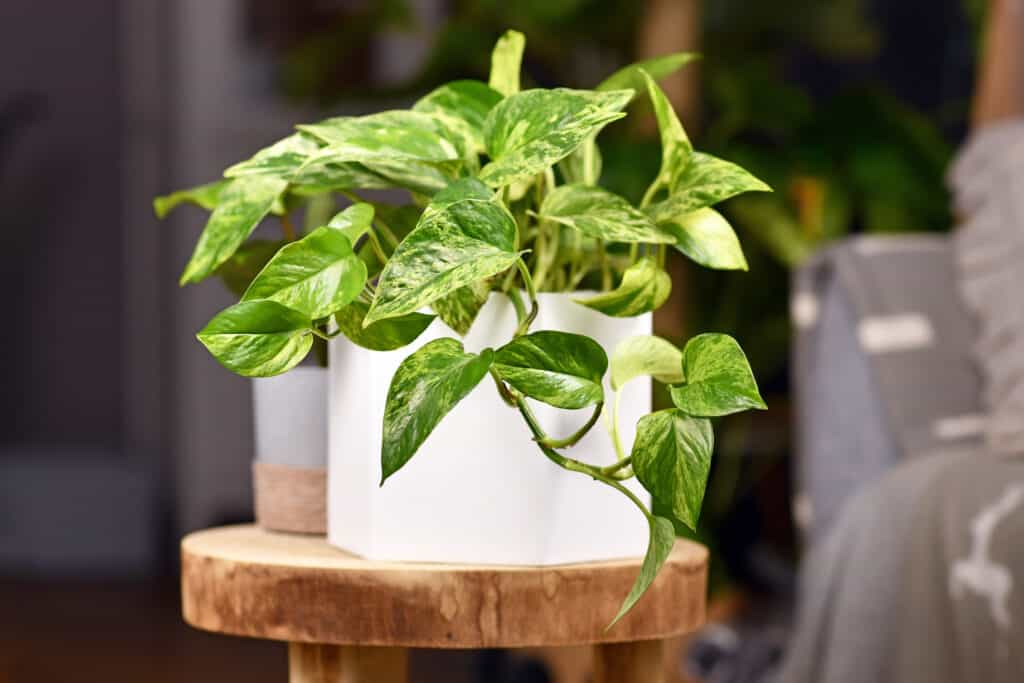
Golden Pothos make an attractive addition to the home.
©iStock.com/Firn
A consistent best seller on plant sites, Golden Pothos is another no-fuss houseplant. It can even thrive in low-light conditions. Its shiny, heart-shaped leaves and vining nature make it a very attractive plant draped on shelves. Pothos is not picky about soil and grows vigorously. Sometimes called Devil’s Ivy, it can return to life even after being neglected. Beginners will have easy success growing this plant indoors.
1. Aloe Vera (Aloe barbadensis)

A popular succulent, Aloe vera has many health benefits.
©iStock.com/klenova
Aloe vera continues to be popular because of its low maintenance. This succulent has short stems with thick, spiky leaves. This cactus-like plant will do well in a sunny window with minimal watering. The gel from aloe vera leaves has several health benefits when used topically, including treating sunburn, moisturizing skin, treating pimples, and removing makeup. Many people keep an aloe vera plant in their kitchen for easy access to the gel inside its leaves.
Summary of the Most Popular Houseplants
| Houseplant | Rank |
|---|---|
| Aloe Vera | 1 |
| Golden Pothos | 2 |
| Snake Plant | 3 |
| Peace Lily | 4 |
| Money Tree | 5 |
| Lucky Bamboo | 6 |
| Spider Plant | 7 |
| African Violet | 8 |
| Jade Plant | 9 |
| Basil | 10 |
| Rosemary | 11 |
| Boston Fern | 12 |
| Rubber Plant | 13 |
| English Ivy | 14 |
| Croton | 15 |
| Areca Palm | 16 |
| Fiddle Leaf Fig | 17 |
| Heartleaf Philodendron | 18 |
| Cactus | 19 |
| Moth Orchid | 20 |
| Dumb Cane Plant | 21 |
| Monstera Deliciosa | 22 |
| ZZ Plant | 23 |
| Pilea | 24 |
| Bromeliads | 25 |
Houseplants make our spaces more beautiful but also have added benefits. Houseplants can improve the quality of indoor air, increase our productivity and creativity, and increase feelings of well-being. Many people love plants in their homes, and these popular houseplants can set up beginners for success.
The photo featured at the top of this post is © denise1203/Shutterstock.com
Thank you for reading! Have some feedback for us? Contact the AZ Animals editorial team.







